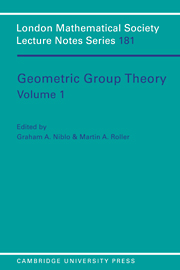Book contents
- Frontmatter
- Contents
- Preface
- List of Participants
- 1 Group Actions and Riemann Surfaces
- 2 The Virtual Cohomological Dimension of Coxeter Groups
- 3 The Geometric Invariants of a Group A Survey with Emphasis on the Homotopical Approach
- 4 String Rewriting — A Survey for Group Theorists
- 5 One Relator Products and High-Powered Relators
- 6 An Inaccessible Group
- 7 Isoperimetric and Isodiametric Functions of Finite Presentations
- 8 On Hibert's Metric for Simplices
- 9 Software for Automatic Groups, Isomorphism Testing and Finitely Presented Groups
- 10 Proving Certain Groups Infinite
- 11 Some Applications of Small Cancellation Theory to One-Relator Groups and One-Relator Products
- 12 A Group Theoretic Proof of the Torus Theorem
- 13 N-Torsion and Applications
- 14 Surface Groups and Quasi-Convexity
- 15 Constructing Group Actions on Trees
- 16 Brick's Quasi Simple Filtrations and 3-Manifolds
- 17 A Note on Accessibility
- 18 Geometric Group Theory 1991 Problem List
8 - On Hibert's Metric for Simplices
Published online by Cambridge University Press: 15 March 2010
- Frontmatter
- Contents
- Preface
- List of Participants
- 1 Group Actions and Riemann Surfaces
- 2 The Virtual Cohomological Dimension of Coxeter Groups
- 3 The Geometric Invariants of a Group A Survey with Emphasis on the Homotopical Approach
- 4 String Rewriting — A Survey for Group Theorists
- 5 One Relator Products and High-Powered Relators
- 6 An Inaccessible Group
- 7 Isoperimetric and Isodiametric Functions of Finite Presentations
- 8 On Hibert's Metric for Simplices
- 9 Software for Automatic Groups, Isomorphism Testing and Finitely Presented Groups
- 10 Proving Certain Groups Infinite
- 11 Some Applications of Small Cancellation Theory to One-Relator Groups and One-Relator Products
- 12 A Group Theoretic Proof of the Torus Theorem
- 13 N-Torsion and Applications
- 14 Surface Groups and Quasi-Convexity
- 15 Constructing Group Actions on Trees
- 16 Brick's Quasi Simple Filtrations and 3-Manifolds
- 17 A Note on Accessibility
- 18 Geometric Group Theory 1991 Problem List
Summary
Abstract. For any bounded convex open subset C of a finite dimensional real vector space, we review the canonical Hilbert metric defined on C and we investigate the corresponding group of isometries. In case C is an open 2-simplex S, we show that the resulting space is isometric to ℝ2 with a norm such that the unit ball is a regular hexagon, and that the central symmetry in this plane corresponds to the quadratic transformation associated to S. Finally, we discuss briefly Hilbert's metric for symmetric spaces and we state some open problems.
Generalities on Hilbert metrics
The first proposition below comes from a letter of D. Hilbert to F. Klein [Hil]. It is discussed in several other places, such as sections 28, 29 and 50 of [BuK], and chapter 18 of [Bui], and [Bea]. There are also nice applications of Hilbert metrics to the classical Perron-Frobenius Theorem [Sae], [KoP] and to various generalizations in functional analysis [Bir], [Bus].
Let V be a real affine space, assumed here to be finite dimensional (except in Remark 3.3), and let C be a non empty bounded convex open subset of V. We want to define a metric on C which, in the special case where C is the open unit disc of the complex plane, gives the projective model of the hyperbolic plane (sometimes called the “Klein model”).
Let x,y ∈ C. If x = y, one sets obviously d(x,y) = 0. Otherwise, the well defined affine line ℓx,y ⊂ V containing x and y cuts the boundary of C in two points, say u on the side of x and v on the side of y; see Figure 1.
Information
- Type
- Chapter
- Information
- Geometric Group Theory , pp. 97 - 119Publisher: Cambridge University PressPrint publication year: 1993
Accessibility standard: Unknown
Why this information is here
This section outlines the accessibility features of this content - including support for screen readers, full keyboard navigation and high-contrast display options. This may not be relevant for you.Accessibility Information
- 45
- Cited by
